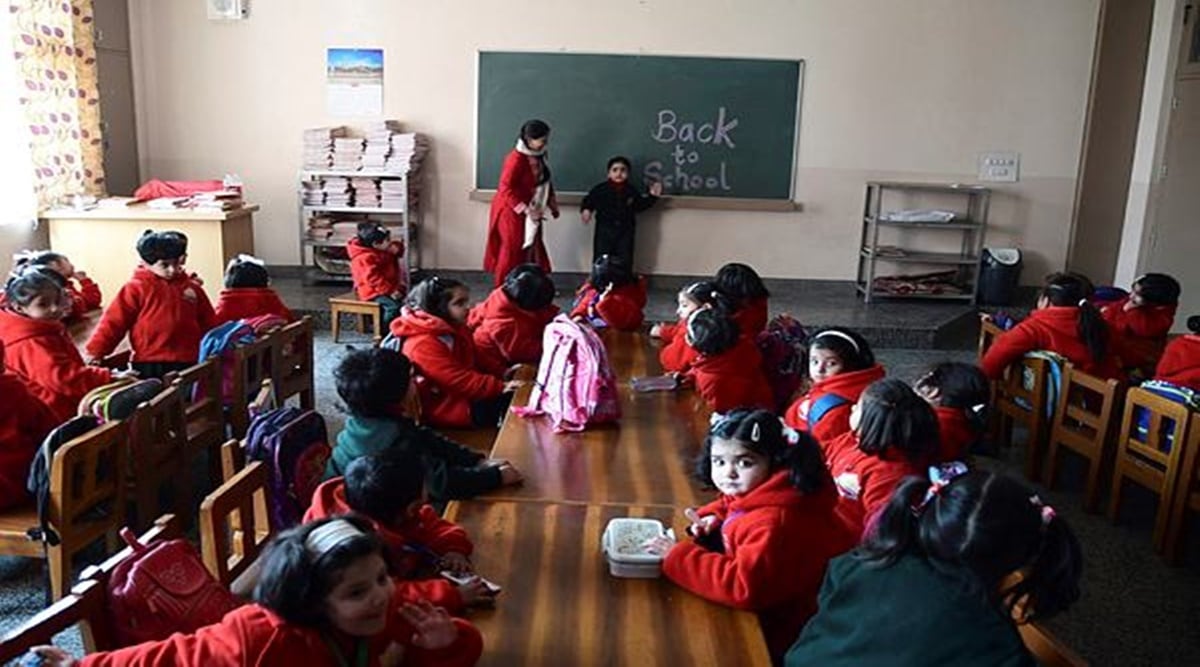 In the beginning, 6,000 primary government schools, with a priority to schools having 300 or more students, will be upgraded to 'emerging schools of excellence' (Express Photo by Shuaib Masoodi/Representational)
In the beginning, 6,000 primary government schools, with a priority to schools having 300 or more students, will be upgraded to 'emerging schools of excellence' (Express Photo by Shuaib Masoodi/Representational)The Gujarat government has decided to upgrade 50 per cent of its total schools as ‘schools of excellence’. The plan is expected to cover 85 per cent — nearly one crore — of total students enrolled in the 40,000 government schools across Gujarat.
Nearly 20,000 schools, including 15,000 primary and 5,000 secondary schools, with an enrollment of 150 or more students will be upgraded as ‘schools of excellence’ to attract students from adjoining areas to these schools. The plan aims to bring down the number of ‘non-viable’ schools. Earlier the state government had planned to merge schools, but it could not be implemented due to opposition from various quarters.
The decision is a part of the ‘Mission Schools of Excellence’ plan, spread over six years, which is being financially supported by the World Bank with $500 million, Asian Infrastructure Investment Bank (AIIB) with $250 million, Asian Development Bank (ADB) with $100 million, which totals to over $850 million, in addition to the state funding and convergence of other local funds totalling to $1.07 billion.
In the beginning, 6,000 primary government schools, with a priority to schools having 300 or more students, will be upgraded to ’emerging schools of excellence’. Aiming at least one in each of the 3250 clusters across 33 districts, such schools have already been identified by the district education officers.
These schools will have strengthened physical and digital infrastructure, performance-linked investment and infrastructure augmentation, in addition, to focus on academic excellence, foundation learning, higher-order thinking skills and new age learning experiences.
For instance, covering the physical infrastructure include adding 10,000 deficit classrooms required in government schools in the first year, apart from STEM lab, computer labs, sports equipment along with strengthening school leadership, data-driven decision making and support and continuous professional development of teachers, headteachers and system officials.
“As a result, these schools of excellence will attract students from nearby schools. These schools with adequate physical and digital infrastructure will be able to attract parents who are ready to overlook the distance their child has to cover if in turn their children are being provided grade appropriate learning outcomes,” Secretary, Education Vinod Rao said adding. Thus, eventually, schools with fewer students will close down.”
State project director of Samagra Shiksha Gujarat, which will handle the administration and implementation of this project, P Bharathi told The Indian Express, “After the rigorous screening and approval process by the World Bank, they have agreed in principle to fund this project of Gujarat education department.”
“The project is spread across six years. It focuses on 50 per cent schools as they have nearly 85 per cent of total students,” said Rao.
This 85 per cent comes out to be nearly 70 lakh students and with nearly 6-7 lakh being added every year in government and grant in aid schools, the education department is aiming to target over 1 crore students to be benefitted from this project over a period of six years.
Further, nearly 450 residential schools for classes VI to XII including model schools, day model schools, Kasturba Gandhi Balika Vidyalaya (KGBVs) under tribal and social justice and empowerment department will be converted into residential schools of excellence.
The education department had announced in August 2019 that in the first phase, around 3,000 government primary schools were to be merged with other government schools within a month. These were out of an estimated number of 5,100 government primary schools across the state with an enrolment of less than 100 and have a second government primary school within one-kilometre radius.
However, due to opposition and protests by Congress, educationists, organisations and teachers associations citing the right to free and compulsory education under the Right to Education (2009) Act, the state government did not give a nod to the plan.
A similar attempt was made in 2013 to merge around 20,000 primary schools with the nearest schools. However, it had also met with opposition from villagers, civil society, educationalists as well as teachers associations citing violation of the Right to Education Act.